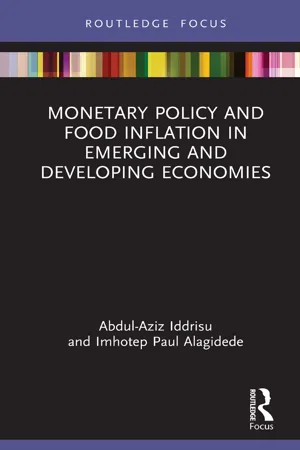
Monetary Policy and Food Inflation in Emerging and Developing Economies
- 136 pages
- English
- ePUB (mobile friendly)
- Available on iOS & Android
Monetary Policy and Food Inflation in Emerging and Developing Economies
About This Book
This book focuses on the impact of monetary policy and food price volatility and inflation in emerging and developing economies.
The tendency for food price volatility to blot inflation forecasting accuracy, engender tail dynamics in the overall inflation trajectory and derail economic welfare is well known in the literature. The ability of monetary policy to exact stability in food prices, theoretically, has also been well espoused. The empirical evidence, however, is not only in short supply, but also the studies available have dwelt on approaches that underplay the volatile behaviour of food prices. This book focuses on inflation targeting in emerging economies such as Chile, Mexico, Turkey, Brazil, Hungary, Russia, Colombia, South Africa, Indonesia and Ghana, as these are economies with considerable proportion of the consumption basket occupied by food. The book provides the means to understand at first hand the correct way to model food inflation, account for the related policy responses to deviations either in the short or medium to long term, and in market conditions that are subject to excessive variability. Strong evidence is presented that captures deviations of food prices from their trend and the accompanying monetary policy effect in stabilizing such variabilities across distinct frequencies. The novel approach in this book addresses the burgeoning puzzles of asymmetry in monetary policy effect on food prices at high, medium and low episodes of food inflation. In doing so, this book presents a powerful tool for researchers interested in understanding not just the transmission mechanism, but also the magnitudes involved, and to policymakers whose existing tools have failed them. Future studies will do well to deepen the evidence and seek new grounds to which the phenomenon manifests beyond and below emerging markets.
This book will be of great interest to students, scholars and policymakers involved in agricultural economics, financial economics, food security and sustainable development.
Frequently asked questions
Information
1 Introduction and background to the study
Introduction
Overview of the book
Structure of the book
- Chapter 1 provides a brief overview and structure of the book.
- Chapter 2 looks at inflation performance, milestones and challenges under the inflation targeting framework in the selected countries. It then compares these outcomes to the performance of inflation prior to the adoption of the targeting framework in each of these countries. In doing so, the chapter also compares actual inflation outturn to the publicly announced inflation targets in these countries.
- Chapter 3 examines the developments in world food prices and the movements in food and overall inflation in the selected countries. It examines the volatilities and persistence in food inflation and the implication for inflation forecasting and conduct of monetary policy in the selected countries.
- Chapter 4 estimates monetary policy effect on food prices in time and frequency domains using the wavelet-based quantile regression approach. This chapter undertakes robustness cheques and discusses the policy ramifications of the results.
- Chapter 5 presents the summary of the journey and explores areas where future research on the topic could yield the greatest reward.
References
- Aguiar-Conraria, L., Azevedo, N., & Soares, M. J. (2008). Using wavelets to decompose the time–frequency effects of monetary policy. Physica A: Statistical Mechanics and its Applications, 387(12), 2863–2878.
- Aguiar-Conraria, L., Martins, M. M., & Soares, M. J. (2018). Estimating the Taylor rule in the time-frequency domain. Journal of Macroeconomics, 57, 122–137.
- Alper, C. E., Hobdari, N., & Uppal, A. (2016). Food inflation in Sub-Saharan Africa: Causes and Policy Implications. IMF Working Paper. WP/16/247.
- Bhattacharya, R., & Jain, R. (2020). Can monetary policy stabilise food inflation? Evidence from advanced and emerging economies. Economic Modelling, 89, 122–141.
- Catao, L. A., & Chang, R. (2015). World food prices and monetary policy. Journal of Monetary Economics 75, 69–88.
- Ginn, W., & Pourroy, M. (2020). Should a central bank react to food inflation? Evidence from an estimated model for Chile. Economic Modelling, 90, 221–234.
- Hammoudeh, S., Nguyen, D. K., & Sousa, R. M. (2015). US monetary policy and sectoral commodity prices. Journal of International Money and Finance, 57, 61–85.
- Iddrisu, A. A., & Alagidede, I. P. (2020). Monetary policy and food inflation in South Africa: A quantile regression analysis. Food Policy, 91, 101816.
- Iddrisu, A. A., & Alagidede, I. P. (2021). Asymmetry in food price responses to monetary policy: A quantile regression approach. SN Business and Economics, 1, 52.
- Portillo, R., Zanna, L. P., O’Connell, S., & Peck, R. (2016). Implications of food subsistence for monetary policy and inflation. IMF Working Paper, WP/16/70.
- Pourroy, M., Carton, B., & Coulibaly, D. (2016). Food prices and inflation targeting in emerging economies. International Economics, 146, 108–140.
2 Inflation targeting framework in emerging and developing economies: Experiences and milestones
Introduction
Table of contents
- Cover
- Half Title
- Series Page
- Title Page
- Copyright Page
- Contents
- List of Figures
- List of Tables
- Preface
- 1 Introduction and background to the study
- 2 Inflation targeting framework in emerging and developing economies: Experiences and milestones
- 3 World food price paths, domestic food and overall prices and monetary policy conduct
- 4 Monetary policy and food price inflation: A wavelet-based quantile regression analysis
- 5 Summary and conclusion
- Index